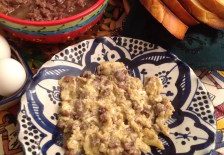Meghli, Lebanon's Own Rice Pudding, Welcomes Babies — Including Jesus
Blanched almonds and pistachios are layered over a dusting of finely chopped coconut in this meghli. (Amy E. Robertson)
By Amy E. Robertson
NPR
Located at a crossroads between East and West, Lebanon’s culinary traditions have been influenced by Syria, Turkey and even France. The country’s international character helps explain why bûche de Noël (yule log cake) is a Christmas staple — a sweet legacy of the French occupation in the first half of the 20th century.
But in traditional Christian homes, Christmas Eve dinner is not complete without meghli, Lebanese-style rice pudding.
Newcomers to the region might not recognize it at first. Instead of the typical creamy white of most rice puddings, meghli is an earthy brown. There are no visible grains of rice. Unlike other rice puddings, meghli is a vegan treat. What appears like chocolate pudding is actually rice flour mixed with water and sugar, tinted brown by copious spices and thickened by careful stirring over the stove.
Joe Barza, Lebanese celebrity chef and food heritage conservationist, says that meghli started out as a straightforward rice porridge. “It was a very simple recipe, which we have developed and is now served in beautiful bowls and with nuts.”
About 35 percent of Lebanon’s 4 million people are Christians, but in Lebanese households of all faiths, families prepare meghli when a baby is born. Mother and infant stay home for the first 40 days after birth, and meghli is offered to every eager guest that comes to meet the baby.
Food activist and author of Lebanese Home Cooking, Kamal Mouzawak, says, “Meghli is brown like the soil, and over it are the nuts — pistachios, walnuts, almonds — like the seeds that will sprout. It symbolizes rebirth.”
Is this symbolism what caused meghli to be associated with newborns? No one really knows, but the most likely explanation can be found in the ingredients. Meghli is heavy on caraway and anise, longstanding home remedies for increasing milk production in new mothers. Cinnamon is said to sweeten mother’s milk. The protein-rich nuts sprinkled on top are believed to help the mother regain her strength.
“Christmas celebrates a newborn,” explains Mouzawak. “It is an old village tradition to make meghli for Christmas. It is very symbolic, very simple and very healthy.” But, he laments, “Today, few make it [at Christmas] any more.”
Both bûche de Noël and meghli have a place at the Christmas table in Marie Therese Maroun’s home, however. According to Maroun, “Bûche de Noël is an ‘exotic’ tradition, but here in Lebanon we eat meghli. It’s part of our Lebanese tradition. At 12 midnight we go to mass. We have the dinner before. We drink wine. And after that we go with the whole family to church.”
Maroun is a young professional whose family has deep roots in Ashrafieh, one of Beirut’s Christian quarters. Maroun’s name reveals her religion: She is a Maronite Christian, a uniquely Lebanese Catholic sect which reveres Saint Maroun, a 4th-century Syriac monk. Maroun’s family recipe tops the meghli with shredded coconut, walnuts, pistachios and raisins.
Rice pudding is a common global Christmas dessert. Scandinavians eat a vanilla-scented version on Christmas Eve. The Danes call it risalamande, and their variation is luxe: whipped cream and chopped almonds are folded in, and it is topped with cherry sauce. Danish custom calls for one whole almond to be hidden in the batch, and whoever finds the almond will have luck all year.
Norway serves its risengrynsgrøt warm, and drops the chopped almonds, whipped cream and cherries in favor of a sprinkling of cinnamon and a large pat of butter melting in the middle of each bowl. In Portugal, arroz doce is enriched with eggs and lemon peel, and is often elaborately decorated with cinnamon. In Puerto Rico, coconut milk stands in for dairy in the classic Christmas dessert arroz con dulce, which is fragrant with cloves and ginger. In each of these countries, the rice pudding tradition remains strong.
Maroun blames Lebanon’s long civil war (1975-1990) and ensuing exodus from the country for the Lebanese loss of traditions. “After the war, and after the emigration, people are no more attached to traditions. But the real Beirut — and not just Beirut, but the people in the villages — they eat meghli.”
Beirut’s historical souk was another piece of heritage that became a casualty of the civil war. Destroyed by shelling, it was replaced after the war by a glitzy open-air shopping center housing the likes of H&M and Gap. The one shop that managed to make a comeback was Al Antabli, which carries on its tradition of selling Arabic-style ice cream, puddings and juices. Al Antabli sells meghli every day of the year — and rather than spending an hour over the stove, you only need 5,000 lira (just over $3).
Like Al Antabli, Maroun is determined to keep traditions alive. This year at Christmas, as always, there will be meghli on her dinner table.








